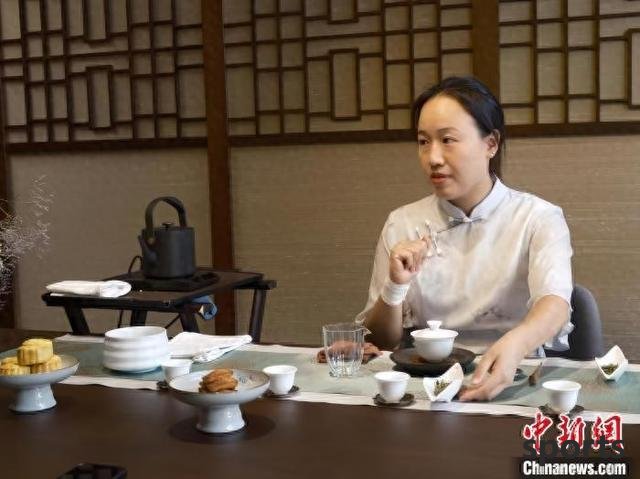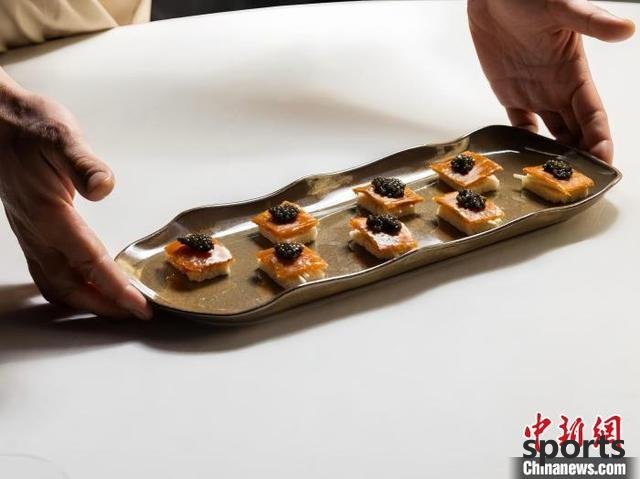Tea restaurants in Milan: "new" and "heart" in dim sum
China News Service, Beijing, May 13 (Reporter Wu Kan) Near the Central Railway Station in Milan, Italy, a tea restaurant called "Mu Dimsum" is full every day. The dim sum in the restaurant that combines Chinese and Western ingredients is not only full of novelty, but also full of thought. Zhou Suili, the restaurant owner and second-generation overseas Chinese, recently interviewed by a reporter from China News Service, about how to explore the "new Chinese food" overseas. Recently, Zhou Ruili was in the "MuDimsum" tea restaurant. (Photo provided by the interviewee) The parents worked in Italy in their early years, and Zhou Saili went to Milan to reunite with her parents when she was 10 years old. In the early 21st century, there were already many Chinese restaurants on the streets of Milan. The "foreign version of Chinese food" such as seafood fried noodles and almond chicken in these restaurants are also the Chinese food flavors in Zhou Saili's memory. "The most common dish at that time was almond chicken. The fried chicken was fried with almonds, and the taste was sour and sweet." Zhou Saili said that in order to cater to the tastes of the locals, Chinese restaurants have transformed these dishes that are different from traditional Chinese food. Although it has enhanced the local people's awareness of Chinese food, it has also made it labeled as cheap fast food for a long time. With the desire to change everyone's stereotypes about Chinese food, Zhou Suili decided to engage in the Chinese food industry. In January 2018, "Milk Dim Sum" officially opened with a restaurant area of 450 square meters, and the Milan Business Center is nearby. The kitchen is completely transparent, and diners can see the entire process of making dim sum. Eat the mountains and eat the mountains and the sea, and fresh ingredients must be found locally. How to use local ingredients to present the taste of Chinese food is a big challenge. Zhou Saili said: "The chef of the restaurant is Malaysian Chinese, and the assistant chef is Italian. We often think and try a dish repeatedly." She gave an example: "The traditional mara cake tastes dry. We use Italian egg sauce to match mara cake, and replaced the masala white wine in the egg sauce with Shaoxing rice wine, adding a different flavor. We also developed black truffle wild mushroom dumplings. The local black truffle is paired with wild mushrooms, which is tender and juicy and has a rich mushroom aroma." The mara cake made by the "MuDimsum" tea restaurant is matched with Italian egg sauce. (Photo provided by the interviewee) Just like red wine can enhance the flavor of Western food, a cup of tea can also make the layering of Chinese food come to the tip of the tongue, the restaurant has been exploring the combination of "tea + food". Zhou Saili said: "We use the refreshing green tea to highlight the flavor of shrimp dumplings, balance the oil of char siu with Pu'er's mellowness, and set off the sweetness of desserts with the sweetness of white tea. At first, many local diners were not used to this combination. After years of promotion, tea meals are now very popular." Restaurant also combines other cuisines to launch a series of new-style dim sum. For example, Beijing roast duck decorated with caviar, Huadiao red shrimp cooked with aged flower-drawn wine, ice cream added with Yunnan duck-feeted wood honey, and crab meat small buns with yellow paste, etc. Zhou Saili introduced that in order to restore the crispy and melt-in-the-mouth texture of the Beijing roast duck skin, it took them a long time to find a suitable duck variety in Ireland. After that, they repeatedly tried the slurry recipe and baking time to ensure that each roast duck was shiny and full when it came out of the oven. Cut the duck skin into small squares when placing the plate, and pair it with caviar and toast. Such roast ducks can sell sixty or seventy ones every week. Roasted duck with caviar made in the tea restaurant of "MuDimsum" (MuDimsum) (Photo provided by the interviewee) In her opinion, in the fast-paced modern life, dining is not only for fullness, but also for relaxing the body and mind, so a comfortable environment is crucial. Echoing the word "wood" in the name, the restaurant furniture is mainly solid wood, and the floor lamp holder is made of natural logs, and the light is sprinkled on the wood carving screen along the wood grain, and time seems to slow down. The purple clay teapot, rattan tray and solid wood chopstick stand on the dining table are arranged in an orderly manner, and the double-sided embroidery and calligraphy and paintings hanging on the wall add a Chinese charm. The window at the entrance of the restaurant displays a variety of tea sets, and there are nearly 40 famous Chinese teas on the tea list. The restaurant holds a tea tasting event once a month to introduce the history and culture of Chinese tea and tea art etiquette. Every Chinese traditional festival restaurant will also produce festival food to let diners understand the traditional festival customs behind it. "When the restaurant first opened, local diners often asked if there were any 'foreign version of Chinese food' such as almond chicken. As everyone's understanding of Chinese food deepened, the demand for ordering such dishes has gradually disappeared." Zhou Saili said that nowadays, not only in major cities such as Milan and Rome, but also in some small and medium-sized cities and tourist hotspots, and major Chinese cuisines and various snacks can be found. "Mujiu" was also included in the Michelin Chinese Food Recommendation List in 2020. Talking about business experience, Zhou Suili said: "It is more about being attentive and trying to do all aspects as meticulously as possible. In the future, we will also carefully prepare every snack to leave unforgettable taste bud memories for diners." 

- Recent Posts
-
- Send the defending champion to
- Times Exclusive: UEFA consider
- Fracture! GMS: Manchester Unit
- Campbell: Arteta already has t
- Gonzalez: Very happy to make m
- Gary Neville: Maduaike is very
- World European Preliminaries -
- Paval: Inter Milan set a goal
- The condition is declining, th
- Miami International defeated P
- Hot Posts
-
- Today s two-string one event:
- Football Preview: Machida Xavi
- 2025 Club World Cup final sche
- Club World Cup Top 32 Tour: Gr
- 32-year-old Son Heung-min will
- Irving: I won t criticize Arno
- Obo: Madison suffered a knee i
- Qiu Yike revealed details of t
- Manchester United lost to Tott
- 1-2! A record-breaking huge 10
- Barcelona young player Dani su
- Official: Brentford buys out B
- Juventus transfer plan: Luis l
- Official: Dortmund buyout defe
- Inter Milan defeated Barcelona
- Double annual salary + Champio
- Second Young Master Dewey is s
- Warnock: Mourinho can lead Lee
- Morati: Have the best players
- Open Day Fan Return
- search
-
- Links
-
